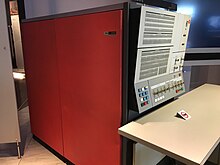
Back System/360 Afrikaans IBM S/360 AST System/360 Bulgarian IBM System/360 Catalan IBM System/360 Czech IBM System/360 Danish System/360 German IBM S/360 Spanish IBM S/360 Finnish IBM 360 et 370 French
 | |
 IBM System/360 Model 30 central processor unit (CPU) | |
| Also known as | S/360 |
|---|---|
| Developer | IBM |
| Manufacturer | IBM |
| Product family | See table of models |
| Type | Mainframe computer |
| Release date | April 7, 1964 |
| Discontinued | 1978 |
| Media | |
| Operating system | |
| Memory | 8 KB – 9 MB (core memory) |
| Predecessor | 700/7000 series |
| Successor | System/370 |
| Related | System/360 architecture |
| History of IBM mainframes, 1952–present |
|---|
| Market name |
| Architecture |
The IBM System/360 (S/360) is a family of mainframe computer systems that was announced by IBM on April 7, 1964, and delivered between 1965 and 1978.[1] It was the first family of computers designed to cover both commercial and scientific applications and a complete range of applications from small to large. The design distinguished between architecture and implementation, allowing IBM to release a suite of compatible designs at different prices. All but the only partially compatible Model 44 and the most expensive systems use microcode to implement the instruction set, featuring 8-bit byte addressing and fixed point binary, fixed point decimal and hexadecimal floating-point calculations.
The System/360 family introduced IBM's Solid Logic Technology (SLT), which packed more transistors onto a circuit card, allowing more powerful but smaller computers.[2]
The slowest System/360 model announced in 1964, the Model 30, could perform up to 34,500 instructions per second, with memory from 8 to 64 KB.[3] High-performance models came later. The 1967 IBM System/360 Model 91 could execute up to 16.6 million instructions per second.[4] The larger 360 models could have up to 8 MB of main memory,[5] though that much memory was unusual; a large installation might have as little as 256 KB of main storage, but 512 KB, 768 KB or 1024 KB was more common. Up to 8 megabytes of slower (8 microsecond) Large Capacity Storage (LCS) was also available for some models.
The IBM 360 was extremely successful, allowing customers to purchase a smaller system knowing they could expand it, if their needs grew, without reprogramming application software or replacing peripheral devices. It influenced computer design for years to come; many consider it one of history's most successful computers.
System/360's chief architect was Gene Amdahl, and the project was managed by Fred Brooks, responsible to Chairman Thomas J. Watson Jr.[5] The commercial release was piloted by another of Watson's lieutenants, John R. Opel, who managed the launch of IBM’s System 360 mainframe family in 1964.[6]
Application-level compatibility (with some restrictions) for System/360 software is maintained to the present day with the System z mainframe servers.
- ^ "IBM System/360 Dates and Characteristics". IBM. 2003-01-23.
- ^ "Why won't you DIE? IBM's S/360 and its legacy at 50". The Register.
- ^ "System 360/30 announcement". IBM. 2003-01-23.
- ^ "System/360 Model 91". IBM. 2003-01-23.
- ^ a b "System/360 Announcement" (press release), IBM Data Processing Division, April 7, 1964, webpage: IBM-PR360: states cycle time from "...millionth-of-a-second to only 200 billionths-of-a-second," and "...memory capacity ranges from 8,000 characters of information to more than 8,000,000."
- ^ "IBM - Former CEO John Opel - An Appreciation". IBM. 24 October 2018.
© MMXXIII Rich X Search. We shall prevail. All rights reserved. Rich X Search